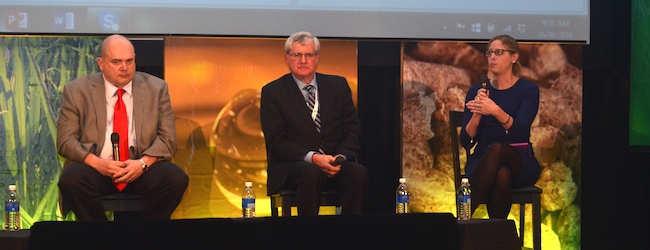
Bioenergy sector’s opportunities and challenges
June 16, 2016
By
Andrew Snook
June 16, 2016 - Where do see opportunities and risks for bioenergy sector in the next decade? That was the question posed to the participants of the executive panel session during the seventh International Bioenergy Conference and Exhibition in Prince George, B.C.
 Carrie Annand
Carrie Annand Gordon Murray, executive director of the Wood Pellet Association of Canada, stated that the wood pellet sector remains the most successful and vibrant sector in the bioenergy industry. However, the sector’s historical biggest challenge still remains an issue that needs to be addressed.
“Domestically here in B.C., fibre supply does continue to be our No. 1 issue,” he told the crowd.
Although the B.C. government has put together a 13-point fibre action plan, Murray said it has yet to assist bioenergy producers in securing additional fibre.
“We do acknowledge that they’ve had good intentions and put a lot of effort forward, but the implementation of this has been frustrating and it has not resulted in any more fibre for us,” he said. “We’d like to see a ban on all slash burning with an exception where the producers can prove that there is no viable option for the residuals.”
As for new opportunities for the wood pellet sector, Murray discussed overseas growth markets such as Japan, which has abandoned nuclear power and has been building biomass-fuelled power plants.
Doug Hooper, director of policy and regulation at Advanced Biofuels Canada, discussed the opportunities for the bioenergy sector related to carbon pricing.
“There’s a large stimulus coming from the carbon funds back into our sectors,” he said.
Hooper added that there would be a long-term reliance on energy dense liquid fuels, including lower carbon renewable biofuels of lower carbon fuels; however, he added that the bioenergy sector needs to improve telling its story on how the sector offers a reliable and versatile source of energy.
“Bioenergy has really got a strong story to tell and I think one of the challenges is how do we tell our story better,” he said.
Carrie Annand, executive vice-president of external affairs for the Biomass Power Association discussed biomass policy in the U.S. She said that one challenge in the U.S. bioenergy sector is getting the different states to acknowledge the positive impacts of a strong biomass industry, including keeping foresters employed, keeping forests intact and creating homes for residuals. She added that you could see the positive affects of the sector in the U.S. states where bioenergy has been embraced.
Michael Weedon, executive director for the BC Bioenergy Network added that the bioenergy sector in B.C. needs to realize that the province doesn’t live in isolation and has to acknowledge global competition.
“We have to offer cost-effective, competitive solutions,” he said.
Weedon added that by focusing on finding “negative carbon” solutions, the province of B.C. will help allow the bioenergy sector’s innovators to come up with profitable solutions.
More coverage of the 2016 International Bioenergy Conference and Exhibition:
Prince George expands DES
Bioenergy, an industry in transition
IBCE 2016 comes to Prince George
Print this page